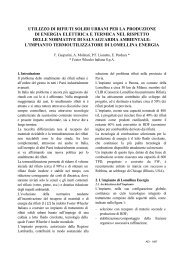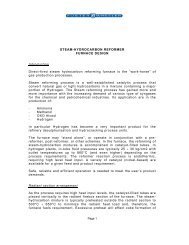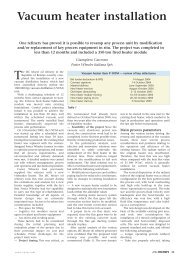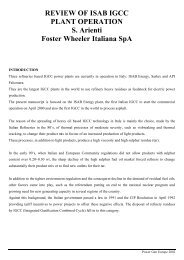Relaying problems in the connection of a dispersed generating plant ...
Relaying problems in the connection of a dispersed generating plant ...
Relaying problems in the connection of a dispersed generating plant ...
Create successful ePaper yourself
Turn your PDF publications into a flip-book with our unique Google optimized e-Paper software.
Figure 5 represents a zoom <strong>of</strong> <strong>the</strong> same locus and <strong>the</strong><br />
quadrilateral operat<strong>in</strong>g characteristic <strong>of</strong> <strong>the</strong> protective<br />
relay <strong>in</strong> station B (first zone only). As dur<strong>in</strong>g generator<br />
power sw<strong>in</strong>gs <strong>the</strong> impedance locus enters <strong>the</strong> relay’s<br />
exist<strong>in</strong>g operat<strong>in</strong>g area, it was necessary to reduce <strong>the</strong><br />
resistive reach below 50Ω (previous sett<strong>in</strong>g) with a<br />
proper marg<strong>in</strong>.<br />
DISTURBANCE TIME TO<br />
REACH 50.5Hz<br />
MAX FREQ. AND<br />
AVERAGE df/dt<br />
100% (*) load reduction 0.17s 51.6Hz 3Hz/s<br />
75% load reduction 0.17s 51.6Hz 2.2Hz/s<br />
50% load reduction 0.5s 51.2Hz 1.2Hz/s<br />
(*) With HV.E-Q52 tripp<strong>in</strong>g and consequent island sequence start<strong>in</strong>g.<br />
Whenever a sudden load reduction greater than 50% <strong>of</strong><br />
<strong>plant</strong> base load is experienced, <strong>the</strong> HV.E-Q52 circuit<br />
breaker trips, thus start<strong>in</strong>g <strong>the</strong> island automatic sequence<br />
that disconnects <strong>the</strong> steam turb<strong>in</strong>e and one gas turb<strong>in</strong>e<br />
and prevents gas turb<strong>in</strong>e motor<strong>in</strong>g (Figure 6).<br />
FIGURE 5. Station B (l<strong>in</strong>e BF) distance relay R,X diagram: a<br />
zoom around <strong>the</strong> zero.<br />
Frequency relay sett<strong>in</strong>g<br />
The power <strong>plant</strong> is requested to operate on restricted<br />
parts <strong>of</strong> <strong>the</strong> 132kV network to ensure supply cont<strong>in</strong>uity<br />
to <strong>the</strong> users <strong>in</strong> case <strong>of</strong> sudden mesh break<strong>in</strong>g. For <strong>the</strong><br />
power <strong>plant</strong>, this situation corresponds to sudden load<br />
reductions, up to full load rejection <strong>in</strong> case <strong>of</strong> very small<br />
residual loads.<br />
The transient performance study <strong>of</strong> <strong>the</strong> <strong>plant</strong> po<strong>in</strong>ted out<br />
that <strong>in</strong> case <strong>of</strong> sudden load reduction greater that 75% <strong>of</strong><br />
base load, motor<strong>in</strong>g <strong>of</strong> gas turb<strong>in</strong>es was to be expected<br />
as a consequence <strong>of</strong> different load shar<strong>in</strong>g among <strong>the</strong><br />
three generators, different <strong>in</strong>ertia constant <strong>of</strong> <strong>the</strong><br />
mach<strong>in</strong>es and different time-response <strong>of</strong> speed<br />
governors: gas turb<strong>in</strong>e generators start to operate as<br />
synchronous motors fed by <strong>the</strong> steam turb<strong>in</strong>e generator.<br />
This operat<strong>in</strong>g condition conflicts not only with turb<strong>in</strong>e<br />
safe operation (<strong>the</strong> anti-motor<strong>in</strong>g relay trips <strong>the</strong><br />
mach<strong>in</strong>e), but also with process requirements (<strong>in</strong><br />
comb<strong>in</strong>ed cycle steam is obta<strong>in</strong>ed from recovery boilers<br />
fed by gas turb<strong>in</strong>e exhausts).<br />
Considered that it is not possible to detect <strong>the</strong> mesh<br />
break<strong>in</strong>g po<strong>in</strong>t a priori, <strong>the</strong> 132kV busbar overfrequency<br />
relay was set to prevent <strong>the</strong> above harmful<br />
situations <strong>in</strong> case <strong>of</strong> operation on very restricted<br />
network islands.<br />
Several frequency trends versus time, correspond<strong>in</strong>g to<br />
sudden switch-over <strong>of</strong> <strong>the</strong> <strong>plant</strong> to different restricted<br />
parts <strong>of</strong> <strong>the</strong> network, were analysed. The sett<strong>in</strong>g <strong>of</strong> overfrequency<br />
relay (f>=50.5Hz, df/dt=1.5Hz/s, t R =0.2s)<br />
was stated on <strong>the</strong> basis <strong>of</strong> <strong>the</strong> results shown <strong>in</strong> Table 3.<br />
TABLE 3 - Frequency trend for different load reduction.<br />
FIGURE 6. Plant frequency versus time (100%, 75%,<br />
50% load reductions).<br />
CONCLUSION<br />
The problem <strong>of</strong> power sw<strong>in</strong>gs as a consequence <strong>of</strong><br />
transient performance <strong>of</strong> generators after fault removal<br />
is well known and easily faced if previously taken <strong>in</strong>to<br />
account <strong>in</strong> <strong>the</strong> plann<strong>in</strong>g stage <strong>of</strong> a transmission network<br />
where large power <strong>plant</strong> are likely to be connected.<br />
On <strong>the</strong> contrary, this may result a problem when power<br />
sw<strong>in</strong>gs occur as a consequence <strong>of</strong> <strong>the</strong> <strong>connection</strong> <strong>of</strong> a<br />
power <strong>plant</strong> on a network planned to operate only<br />
supply<strong>in</strong>g loads. False tripp<strong>in</strong>g <strong>of</strong> l<strong>in</strong>e distance relays is<br />
to be expected with <strong>the</strong> consequent risk <strong>of</strong> network<br />
separation <strong>in</strong> unexpected po<strong>in</strong>ts, thus <strong>in</strong>creas<strong>in</strong>g <strong>the</strong> risk<br />
<strong>of</strong> network blackout.<br />
The paper illustrated <strong>the</strong> benefits obta<strong>in</strong>ed from a<br />
stability study <strong>in</strong> <strong>the</strong> sett<strong>in</strong>g <strong>of</strong> l<strong>in</strong>e distance relays<br />
previously <strong>in</strong>stalled on a 132kV network, where a new<br />
power <strong>plant</strong>, 140MW, was set up.<br />
The simulation <strong>of</strong> several disturbances allowed <strong>the</strong><br />
sett<strong>in</strong>g <strong>of</strong> <strong>the</strong> exist<strong>in</strong>g distance relays without add<strong>in</strong>g<br />
any power-sw<strong>in</strong>g block<strong>in</strong>g function.<br />
The <strong>plant</strong> has been <strong>in</strong> operation for two years: few<br />
disturbances on <strong>the</strong> network have been experienced so<br />
far and no unwanted tripp<strong>in</strong>g <strong>of</strong> distance relays<br />
occurred.
















